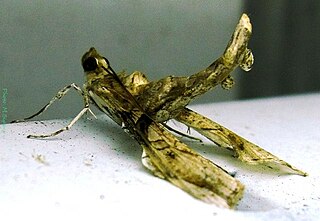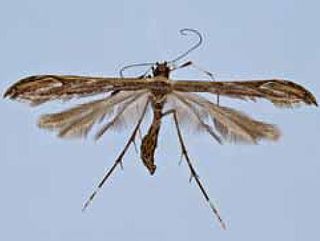Genophantis leahi was a species of moth in the family Pyralidae described by Otto Herman Swezey in 1910. It was endemic to the Hawaiian islands of Maui, Oahu, Molokai and Hawaii.

Simosyrphus grandicornis is an Australasian species of hoverfly, and is one of the two most common hoverflies in Australia, alongside Melangyna viridiceps. It has been introduced to a number of Polynesian Islands and Hawaii.

Cellana sandwicensis, common name the yellow-foot ʻopihi, is a species of edible true limpet, a marine gastropod mollusc in the family Nacellidae, one of the families of true limpets.

Omiodes demaratalis, the Hawaiian grass leafroller, is a species of moth in the family Crambidae. It is endemic to the Hawaiian islands of Niihau, Kauai, Oahu, Molokai, Maui and Hawaii.

Omiodes blackburni, the coconut leafroller, is a species of moth in the family Crambidae. It is endemic to the Hawaiian islands of Kauai, Oahu, Molokai, Maui, Lanai and Hawaii. The species was first described by Arthur Gardiner Butler in 1877.

Macaria abydata, commonly known as the dot-lined angle, is a moth of the family Geometridae. It is native from northern Argentina to the Caribbean and southern United States. It has been introduced to the Pacific and has spread rapidly since. The first introduction occurred in Hawaii in 1970. Further spread occurred as follows:
Dichomeris acuminata, the alfalfa leaf tier, is a moth of the family Gelechiidae. It was first described by Otto Staudinger in 1876. It is a widely distributed species, being known from India, Myanmar, and Sri Lanka southwest to the Seychelles, Mauritius and Réunion and on to Egypt, east and South Africa and southern Europe. Eastward from India it extends through Indonesia and Malaysia to Taiwan and Australia. It is also found in Japan, the West Indies, North America and Hawaii.
Pectinophora scutigera, the Queensland pink bollworm or pinkspotted bollworm, is a moth of the family Gelechiidae. It was described by Holdaway in 1926 from Australia, where it occurs in coastal and central Queensland. It has also been recorded from Hawaii, New Guinea, Micronesia and New Caledonia.

Terastia subjectalis is a moth of the family Crambidae. It occurs across the Indian and south Pacific oceans, including Fiji, Hawaii, Réunion, Okinawa, Samoa, the Society Islands, Sri Lanka and Australia.

Omphisa anastomosalis, the sweetpotato vineborer, is a moth of the family Crambidae. It is widespread, with records including the Philippines, Indonesia, New Guinea, India, Sri Lanka, Malaysia, Taiwan, Hawaii, Vietnam, China, Japan, Cambodia, Laos, Burma and Thailand.
Omiodes iridias is a moth of the family Crambidae. It is endemic to the island of Hawaii.
Omiodes monogramma is a moth of the family Crambidae. It is endemic to the Hawaiian islands of Kauai, Oahu, Molokai and Hawaii.

Parapoynx fluctuosalis or Fluctuating China-mark or Waved China-mark, is a moth of the family Crambidae. It is a widespread species, known from Africa, India, Sri Lanka, China, Japan, Malaysia, Taiwan, Guam, Hawaii, Fiji, Australia and the Galápagos Islands. It is also an introduced species in Europe, where it has been recorded from Great Britain, the Iberian Peninsula and Sardinia.

Elophila obliteralis, the waterlily leafcutter moth, is a moth of the family Crambidae. It was described by Francis Walker in 1859. It is native to eastern North America. It is an introduced species in Hawaii and South Africa.

Hypsopygia mauritialis is a moth of the family Pyralidae described by Jean Baptiste Boisduval in 1833. It is a widespread species, known from Africa, India, China, Malaysia, Taiwan, Japan, Australia and Hawaii.
Tamsica homodora is a moth of the family Crambidae. It is endemic to the Hawaiian island of Oahu.
Tamsica hyacinthina is a moth of the family Crambidae. It is endemic to the Hawaiian islands of Oahu and Hawaii.
Tamsica hydrophila is a moth of the family Crambidae. It is endemic to the Hawaiian island of Oahu.

Hellinsia beneficus is a moth of the family Pterophoridae. It is native to Mexico, but was introduced to Hawaii in 1973 as a biological control agent against mistflower, Ageratina riparia.
Carposina viridis, the green carposinid moth, is a moth of the family Carposinidae. It was first described by Lord Walsingham in 1907. It is endemic to the Hawaiian islands of Kauai and Oahu.










